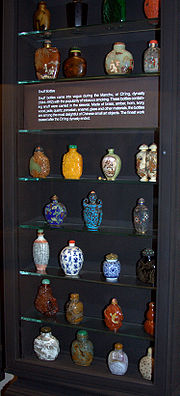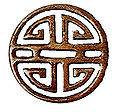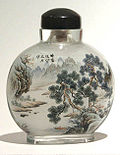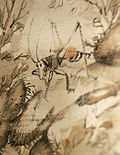
Snuff bottle
Encyclopedia

China
Chinese civilization may refer to:* China for more general discussion of the country.* Chinese culture* Greater China, the transnational community of ethnic Chinese.* History of China* Sinosphere, the area historically affected by Chinese culture...
during the Qing Dynasty
Qing Dynasty
The Qing Dynasty was the last dynasty of China, ruling from 1644 to 1912 with a brief, abortive restoration in 1917. It was preceded by the Ming Dynasty and followed by the Republic of China....
to contain powdered tobacco. Smoking tobacco was illegal during the Dynasty, but the use of snuff was allowed because the Chinese considered snuff to be a remedy for common illnesses such as colds, headaches and stomach disorders. Therefore, snuff was carried in a small bottle like other medicines. The snuff bottle is comparable to the snuff box used by Europeans.
Tobacco was introduced to the court at Beijing
Beijing
Beijing , also known as Peking , is the capital of the People's Republic of China and one of the most populous cities in the world, with a population of 19,612,368 as of 2010. The city is the country's political, cultural, and educational center, and home to the headquarters for most of China's...
some time during the mid- to late-16th century. It was originally smoked in pipes before the establishment of the Qing Dynasty. The use of snuff and snuff bottles spread through the upper class, and by the end of the 17th century it had become a part of social ritual to use snuff. This lasted through most of the 18th century. Eventually, the trend spread into the rest of the country and into every social class. It was common to offer a pinch of snuff as a way to greet friends and relatives. Snuff bottles soon became an object of beauty and a way to represent status. The highest status went to whoever had the rarest and finest snuff bottle. The peak of snuff bottle manufacture was during the 18th century.
The use of snuff increased and decreased with the rise and fall of the Qing Dynasty and died away soon after the establishment of the Republic of China
Republic of China
The Republic of China , commonly known as Taiwan , is a unitary sovereign state located in East Asia. Originally based in mainland China, the Republic of China currently governs the island of Taiwan , which forms over 99% of its current territory, as well as Penghu, Kinmen, Matsu and other minor...
. However, replica snuff bottles are still being made, and can be purchased in souvenir shops, flea markets and museum gift shops. Original snuff bottles from the Qing period are a desirable target for serious collectors and museums. A good bottle has an extra quality over and above its exquisite beauty and value: that is touch. Snuff bottles were made to be held and so, as a rule, they have a wonderful tactile quality.
Materials and size
The size of a snuff bottle is small enough to fit nicely inside the palm. Snuff bottles were made out of many different materials including porcelainPorcelain
Porcelain is a ceramic material made by heating raw materials, generally including clay in the form of kaolin, in a kiln to temperatures between and...
, jade
Jade
Jade is an ornamental stone.The term jade is applied to two different metamorphic rocks that are made up of different silicate minerals:...
, ivory
Ivory
Ivory is a term for dentine, which constitutes the bulk of the teeth and tusks of animals, when used as a material for art or manufacturing. Ivory has been important since ancient times for making a range of items, from ivory carvings to false teeth, fans, dominoes, joint tubes, piano keys and...
, wood
Wood
Wood is a hard, fibrous tissue found in many trees. It has been used for hundreds of thousands of years for both fuel and as a construction material. It is an organic material, a natural composite of cellulose fibers embedded in a matrix of lignin which resists compression...
, tortoiseshell
Tortoiseshell material
Tortoiseshell or tortoise shell is a material produced mainly from the shell of the hawksbill turtle, an endangered species. It was widely used in the 1960s and 1970s in the manufacture of items such as combs, sunglasses, guitar picks and knitting needles...
, metal
Metal
A metal , is an element, compound, or alloy that is a good conductor of both electricity and heat. Metals are usually malleable and shiny, that is they reflect most of incident light...
and ceramic
Ceramic
A ceramic is an inorganic, nonmetallic solid prepared by the action of heat and subsequent cooling. Ceramic materials may have a crystalline or partly crystalline structure, or may be amorphous...
, though probably the most commonly used material was glass. The stopper usually had a very small spoon attached for extracting the snuff. Though rare, such bottles were also used by women in Europe in Victorian times, with the bottles typically made of cut glass.
Chinese snuff bottles were typically decorated with paintings or carvings, which distinguished bottles of different quality and value. Decorative bottles were, and remain, time-consuming in their production and are thus desirable for today's collectors.
Symbolism in snuff bottle decoration

Longevity
The word "longevity" is sometimes used as a synonym for "life expectancy" in demography or known as "long life", especially when it concerns someone or something lasting longer than expected ....
, illustrated at right. Shou or Sau was one of Three Star Gods.
Another popular device is a representation of the 18 Lohan, who were the personal disciples of Buddha, just one group of the many revered immortals in China. Apart from the 18 Lohan there is a constellation of other divines who are portrayed, even their innards. The eight precious organs of the Buddha are venerated - his heart, gall bladder, spleen, lungs, liver, stomach, kidneys and intestines. These are rarely depicted on snuff bottles. Animals, on the other hand appear with regularity, the most common being the dragon.



Other commonly used symbols
The three legged toad is a mythical creature. It was thought to be an animated purse containing an inexhaustible supply of coins, hence it represents wealth and has become a symbol of the unattainable.The fish is both an emblem of wealth and abundance and of harmony and connubial bliss. The fish emblem is used in a variety of decorative ways. Bamboo is a frequent motif. Because of its durability and its being evergreen it has come, along with many other symbols, to signify longevity.
"Inside painted" bottles

Inner painting
Inner painting , also known as inner drawing or inside painted, is a Chinese art form. It involves glass bottles which have pictures and often calligraphy painted on the inside surface of the glass. The bottles are produced by manipulating a specialized paint brush through the neck of the...
. These are glass bottles which have pictures and often calligraphy
Calligraphy
Calligraphy is a type of visual art. It is often called the art of fancy lettering . A contemporary definition of calligraphic practice is "the art of giving form to signs in an expressive, harmonious and skillful manner"...
painted on the inside surface of the glass.
These delightful scenes are only an inch or two high and are painted while manipulating the brush through the neck of the bottle maybe only a quarter inch across, and also painted in reverse. Ursula Bourne, in her treatise on snuff, suggests that artisans painted on their backs to make it easier to work through the narrow opening.
It has been said that a skilled artist may complete a simple bottle in a week while something special may take a month or more and that the best craftsmen will produce only a few bottles in a year.

The earliest inside painted bottles are thought to have been made in the period between 1820 and 1830 as, by then, the beauty of a snuff bottle was probably more important than utilitarian considerations—-and considering this—few would have been used for holding snuff. Inside painted bottles are still made today—expensively for collectors and inexpensively as souvenirs.
Like other types of snuff bottle, the range of subject matter used on inside painted bottles is without limit. There are scenes, fish, birds, poems, even portraits. They are testament to the skill and inventiveness of Chinese craftsmen.

